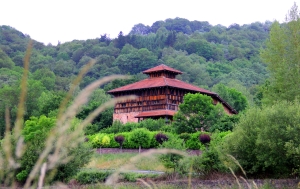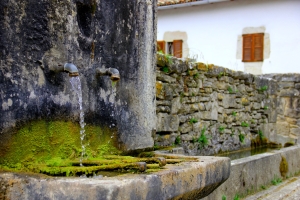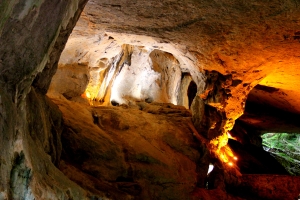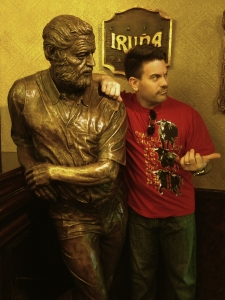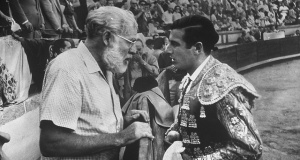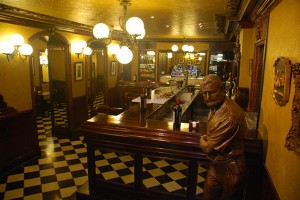The rain in Spain stays mainly in the plain.
That famous song and scene from My Fair Lady depicts Audrey Hepburn learning to pronounce the long A vowel sound in English. I wish my students displayed such a love for education as she does. Alas, they do not.
The most difficult aspect of my job this year, teaching in an Opus Dei high school in Pamplona is a single question: What kind of adults does a school system create? Or to put it another way, how does the school system affect the culture of a nation and its people?
40 years of a fascist government under Francisco Franco has dictated (no pun intended) the direction that the culture has shifted. You’re probably scratching your head and wondering how one has anything to do with the other. Well, let me connect the dots for you.

The first element of this equation is the culture. Spaniards are known to be a very friendly and relaxed people (see my other article about it). Because of that, they don’t put as much emphasis on work or career that Americans or Germans do. The Spaniards simply enjoy their lives to the fullest. Not that there’s anything wrong with that.
The second element is the aftermath of Franco’s regime. For generations, who are still very much alive and can remember, Spain wasn’t allowed any semblance of freedom. Franco told everyone what to do, how to do it, when and where to do it, etc. When the country became a democracy in 1975, the pendulum swung the other way completely. Now, there’s a underlying feeling of political correctness in the air.

Add these two parts together and what do you get? One of those firecrackers that doesn’t go off. Students in Spain lack any type of motivation to learn. It’s a struggle to get even the brightest of minds to complete his homework or ask a question in class. They rush through their assignments so that they can play smartphone games, or join their friends on the soccer pitch (don’t get me started on Europeans’ obsession with soccer).
So what came first? The proverbial chicken or the egg?
The students seem to want to do only the bare minimum of work to get through the class. There isn’t any inherit curiosity about their world. There isn’t any value for education or where a good one will take them in the future. Most importantly is something I’ve noticed in all my travels. The United States gets a bad reputation all over the world. We aren’t loved, and I’m not sure we ever were. When I first began teaching, it was my goal to escape my home country.

Four years later, I have now found the single greatest thing that makes America and Americans great. Critical thinking. No nation on the globe teaches their students to be critical thinkers like the US does. Sure, I’m speaking in broad generic strokes and there may be elements of it in other countries (I’m sure the U.K. and Germany do a pretty damn good job too). But overall, from Turkiye and Spain to China and South Korea, there is no emphasis placed on a learner’s ability to plan ahead. There’s just not enough problem solving going on.
In Spain specifically, the reason goes again back to their government. Most students want to scrape by because when they graduate, they want to get a civil service job. There are 46 million people living in Spain and 3 million federal civil service positions including administrators, police, healthcare, and even street sweepers to name a few. There are even more per capita region by region.
With a gradually decreasing unemployment rate (from 23%-20% in just one year), and so many civil service positions available for many who do not have an education, students in Spain just don’t have the motivation to apply themselves. And the few that do, haven’t developed the necessary critical thinking skills to succeed (they’re too content to play their video games and text with their friends all the time – check out this article from the Guardian).
From early primary school, children aren’t taught to behave properly in public. I have seen it in my school and in other schools. From the age of 3+, they run around like wild animals, screaming and fighting, and doing God knows what else. It is this awful behavior (which remains uncorrected by both parents and teachers) that continues through secondary school. Unlike in Turkiye, Spanish students do not get 10 minute breaks between classes, but classes run together as the schedule is written, making the transition between lessons confusing.
Additionally, the long lunch break affects learning as well. Students are in school between 8:30 and 11:15. Then they get a 30 minute recess. From 11:45 to 1:20, they are in classes again, but the two hour lunch break follows and the next class doesn’t begin until 3:10. This concept is bad enough for teenagers, but the schools subject primary school and even kindergarten students to it as well. Can you imagine a classroom of 25 four-year-olds stuck in school from 8:30 to 4:50? It’s baffling.

To sum up, four countries with four distinct educational systems. The only real insight I’ve gathered is that parental involvement is key. Parents need to show their children that they not only care about them, but they care about their education. Students need to build self–respect, because if they can’t respect themselves, they’re certainly not going to respect anyone (or anything) else. After all, education is the silver bullet.
We don’t need little changes, we need gigantic, monumental changes. Schools should be palaces. Competition for the best teachers should be fierce. Teachers should be making six figure salaries. Schools should be incredibly expensive for government and absolutely free to the citizens.
Let’s figure out how to do it. Thanks, Sam Seaborn.
Hasta La Promixa…
-Justin

